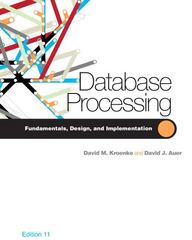Question
Regulation: Implement our algorithms in GPU-based Keras, Tensorflow, Pytorch or Matlab environments. If codes are implemented in another environment, no points will be given. If
Regulation:
Implement our algorithms in GPU-based Keras, Tensorflow, Pytorch or Matlab environments. If codes are implemented in another environment, no points will be given.
If students do not follow the requirements to select the datasets and neural network models, no points will be given.
Description:
The course projects focus on the following two aspects.
Implement the basic deep convolutional neural networks to an advanced GPU-based environment (Keras, Tensorflow, Pytorch and Matlab).
Compare the performance differences with the condition of learning from scratch by using different network archietcture.
Section I: Used datasets
Use one of the following datasets according to your student last digit of your student ID.
(the last digit of ID belongs to 1-2): Scene-15 dataset and Caltech101
(the last digit of ID belongs to 3-4): Scene-15 dataset and Caltech256
(the last digit of ID belongs to 5-7): CIFAR10
(the last digit of ID belongs to 8-9, 0): CIFAR100
How to construct the training and testing dataset
For mnist, CIFAR10/100, the training set, and testing set were organized.
For Caltech101/256, the method to generate the training and testing dataset could be found in http://places2.csail.mit.edu/PAMI_places.pdf. (30 image per class for training dataset, remaining images are used for testing)
For Scene15, randomly select 100 images per class for training, remaining images are used for testing.
Section II: Custom your own network architecture
At least five convolutional layers in your network
Different learning rates for different convolutional layers
Project requirements
Training the given datasets (shown in Section I) with the customed network architecture (shown in Section II). Students need to complete the following tasks. Students should provide codes and the related experimental results such as experimental settings, figures, log files, etc. to validate the results they obtained.
Run your DCNN model from Section 2 with the data from Section 1 from scratch, take the average training and testing accuracy from three runs.
Find the dataset make a program according the information and make sure add dataset link in answer. Make sure all requirements filled in Program and mention which algorithm using.
Step by Step Solution
There are 3 Steps involved in it
Step: 1

Get Instant Access to Expert-Tailored Solutions
See step-by-step solutions with expert insights and AI powered tools for academic success
Step: 2

Step: 3

Ace Your Homework with AI
Get the answers you need in no time with our AI-driven, step-by-step assistance
Get Started


